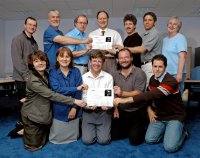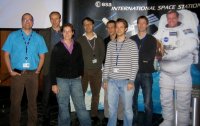1000th Orbit for the Cluster Mission
29 December 2006
Today, 29 December 2006, marks the 1000th orbit around the Earth of the four ESA satellites composing the Cluster mission. Launched in the summer 2000, these spacecraft are delivering a unique harvest of in-situ scientific data of the Earth environment, from 25 000 to 125 000 kilometres altitude.Cluster is the first scientific mission in space history composed of four spacecraft flying in formation able to map the Earth's environment in 4 dimensions, both space and time. This experimental breakthrough is a leap ahead for scientists around the world, enabling them to understand the impact of the Sun's activity on the Earth's environment including how, where and under which conditions, solar material penetrates the Earth's magnetic shield. This knowledge is of crucial importance to accurately forecast the occurrence of magnetic storms and their consequences on critical technology infrastructure both in space and on Earth (satellite failures, inaccurate GPS positioning, pipeline corrosion...).
Over the past 6 years, more than 300 000 CDs (compact disks) of scientific data collected in space by the Cluster mission have been delivered to scientists all over the world. In Europe, the music industry would award a platinum record to the Cluster mission for such impressive output. In terms of science, these data have led to more than 800 (and counting!) scientific publications, including more than 550 peer-reviewed articles published in the most prestigious scientific journals.
But this on-going scientific success would have never been achieved without the dedication of the 11 scientific experiment teams (9 in Europe and 2 in the USA) led by 11 Principal Investigators (PI), the personnel of the Rutherford Appleton Laboratory (UK) and the European Space Agency involved on this mission.
ESTEC
The Cluster project scientist at the European Space research and TEchnology Center (ESTEC, Noordwijk, The Netherlands) of ESA is in charge of coordinating the input of the different PIs in order to maximise the scientific return of the mission. This includes the choice of the separation between the spacecraft in terms of science objectives. "Physical phenomena in the Earth's environment operate at different scales. Improving our understanding of these phenomena require to probe them with various distances between the Cluster satellites. But the fuel on each platform is limited and fruitful discussions with all the PIs together with ESA flight dynamics engineers have been necessary to pick up the appropriate separation distances", said Philippe Escoubet, ESA Cluster project scientist (Image 4).
JSOC
 |
|
Image 1. Cluster team at JSOC |
ESOC
 |
 |
|
Image 2. Cluster Flight Control Team at ESOC |
Image 3. Cluster spacecraft controllers at ESOC |
The Cluster team at ESOC practically operates the Cluster satellites on a daily basis. It is composed of spacecraft controllers (SPACON), and engineers headed by a spacecraft operations manager (Image 2). Whenever a Cluster satellite is in contact with an ESA ground station, there is one SPACON present in the Cluster dedicated control room at ESOC, 24 hours a day, 7 days a week (Image 3).
In addition to the routine SPACON shift, an on-call operations engineer is also available by phone to quickly react to any problem. During critical operations, like manoeuvres, the on-call engineer is present in the Cluster Control Room.
Crucial work has been performed at ESOC, in particular to optimise the fuel consumption on each Cluster platform. This work has prolonged the lifetime of the Cluster mission and therefore enhanced its scientific return. Recently, another crucial contribution of the ESOC team has been the successful design of a special operational mode which optimises the lifetime of the batteries (which naturally degrade through time) on each platform during long eclipses. In the long run, it seems obvious that the experience gained in operating this complex mission will be an asset for future ESA multi-spacecraft missions.
Cluster Active Archive
 |
|
Image 4. Cluster team and CAA team at ESTEC |
"Cluster data are public domain. An on-going effort is financed by the European Space Agency to make it available online with the highest time resolution and quality. The so-called Cluster Active Archive (CAA) is accessible at http://caa.estec.esa.int/ [see related links on the right-hand side]. We are building a gold mine of magnetospheric data and we invite the whole world to use it", says Philippe Escoubet Cluster project scientist of the European Space Agency.
Contact
Web story author and co-editor
Arnaud Masson, SCI-SO division, RSSD, ESA, The Netherlands
e-mail: Arnaud.Masson esa.int
esa.int
phone: +31-71-565-5634
Web story editors
Philippe Escoubet, SCI-SM division, RSSD, ESA, The Netherlands
e-mail: Philippe.Escoubet esa.int
esa.int
phone: +31-71-565-4564/8009
Matthew Taylor, SCI-SO division, RSSD, ESA, The Netherlands
e-mail: Matthew.Taylor esa.int
esa.int
phone: +31-71-565-8009

